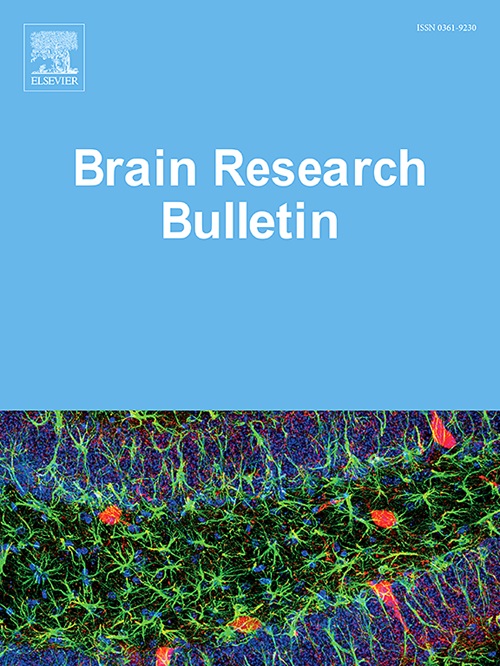结构和功能连接耦合作为肺癌患者骨转移性疼痛的影像学标志物。
IF 3.5
3区 医学
Q2 NEUROSCIENCES
引用次数: 0
摘要
背景:癌性疼痛是恶性肿瘤患者的常见症状,与预后差、死亡风险高相关。结构连接(SC)和功能连接(FC)偶联尚未在肺癌骨转移性疼痛患者中进行探讨。方法:前瞻性纳入51例无骨转移性疼痛(BMP-)肺癌患者、52例骨转移性疼痛(BMP+)肺癌患者和28例健康对照(HC)。首先,在全球、区域和模块化水平上测量和分析了SC-FC耦合。随后,基于欧几里得距离度量,构建了个性化SC-FC耦合网络。此外,选择卷积神经网络(CNN)模型对基于个性化网络的三组进行分析和分类。结果:偶联分析表明,与肺癌本身相关的较弱SC-FC偶联存在于多个层面,包括全球、区域、网络间和网络内的偶联。值得注意的是,与骨转移性疼痛相关的超偶联存在于多个脑区,主要涉及默认模式网络、额顶叶网络、突出网络和边缘系统。右侧杏仁核的区域耦合与BMP+的数值评定量表评分之间存在显著的正相关。此外,在个性化网络上建立的CNN模型表现出了较好的分类性能。结论:SC-FC偶联模式的改变可能在骨转移性疼痛的发生和调节中起重要作用。了解这些变化可以为癌症疼痛背后的神经机制提供有价值的见解。本文章由计算机程序翻译,如有差异,请以英文原文为准。
Structural and functional connectivity coupling as an imaging marker for bone metastasis pain in lung cancer patients
Background
Cancer pain is a common symptom in patients with malignant tumors and associated with poor prognosis and a high risk of death. Structural connectivity (SC) and functional connectivity (FC) couplings have not yet been explored in lung cancer patients with bone metastasis pain.
Methods
In total, 51 patients with lung cancer without bone metastasis pain (BMP–), 52 patients with lung cancer with bone metastasis pain (BMP+), and 28 healthy controls (HC) were prospectively enrolled in our study. Firstly, SC–FC couplings were measured and analyzed at global, regional, and modular levels. Subsequently, individualized SC-FC coupling networks were constructed based on the Euclidean distance metric. In addition, the convolutional neural network (CNN) model was selected to analyze and classify three groups based on individualized networks.
Results
The coupling analysis demonstrated that weaker SC–FC couplings related to lung cancer itself were present at various levels, including global, regional, inter-network, and intra-network couplings. Notably, hyper-couplings related to bone metastasis pain were present in several brain regions, mainly involving the default mode network, frontoparietal network, salience network, and limbic system. Significant positive correlations were observed between regional coupling in the right amygdala and the numeric rating scale scores in BMP+. Moreover, CNN model built on individualized networks exhibited relatively great classification performance.
Conclusion
Alterations in SC–FC coupling patterns may play a crucial role in the development and modulation of bone metastasis pain. Understanding these changes could provide valuable insights into the neural mechanisms underlying cancer pain.
求助全文
通过发布文献求助,成功后即可免费获取论文全文。
去求助
来源期刊

Brain Research Bulletin
医学-神经科学
CiteScore
6.90
自引率
2.60%
发文量
253
审稿时长
67 days
期刊介绍:
The Brain Research Bulletin (BRB) aims to publish novel work that advances our knowledge of molecular and cellular mechanisms that underlie neural network properties associated with behavior, cognition and other brain functions during neurodevelopment and in the adult. Although clinical research is out of the Journal''s scope, the BRB also aims to publish translation research that provides insight into biological mechanisms and processes associated with neurodegeneration mechanisms, neurological diseases and neuropsychiatric disorders. The Journal is especially interested in research using novel methodologies, such as optogenetics, multielectrode array recordings and life imaging in wild-type and genetically-modified animal models, with the goal to advance our understanding of how neurons, glia and networks function in vivo.
 求助内容:
求助内容: 应助结果提醒方式:
应助结果提醒方式:


